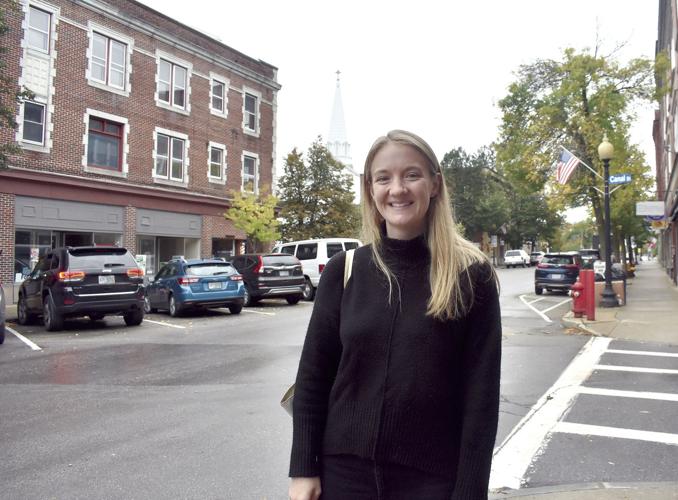LACONIA — Faith McEvoy cringes when she recalls the drama of her teenage years: losing and gaining friends, feeling uncomfortable in her own skin, striving to please others at her own expense.
The memory that stands out most is the condition that plagued her senior year: a cycle of bingeing and purging — an expression of her anxiety and depression, she said. It was a desperate attempt to control her life at a time when image and achievement were all-consuming.
With other girls at Bishop Brady High School in Concord, McEvoy compared what she ate and didn’t eat. She told a friend she’d confided in since third grade about how she would consume what she could find, throw up, and not eat again for several days, until ravenous hunger made her eat uncontrollably again.
“She saw the depression and weight loss and weird habits I was in,” said McEvoy, a Laconia resident.
Today, at age 23, McEvoy exercises within safe limits, eats healthy foods, and indulges in treats when she wants — a pattern that gives her stability, energy, and clarity, and protects her mood, she said.
She works as a legal assistant while preparing to apply to law school with her eyes on a career in criminal law. She carefully guards her recovery, and wastes no time encouraging others to seek help.
“Having an eating disorder feels like a flaw,” McEvoy said. “Forgiving yourself is a huge thing. It’s such an unhealthy thing to live with.”
When the pattern of self-destruction becomes entrenched, she said, “you could kill yourself.”
Deadly disorder
According to research cited by the National Eating Disorder Association, eating disorders claim a life every 62 minutes as a result of medical complications or suicide. The number of Americans known to have them has more than doubled in the last 10 years, partly because more people are seeking treatment as discrimination toward people battling mental illness has waned, according to studies cited by NEDA.
Anorexia nervosa, characterized by restrictive eating and compulsive exercise that triggers dangerous weight loss, is the second-deadliest mental illness after opioid addiction, causing death for 10 percent of those afflicted. According to the most recent statistics — which are now 12 years old — anorexia affects 1 percent of females and 0.3 percent of males. Today it’s as common in girls as autism, according to current research.
Bulimia nervosa — purging food before it’s assimilated — is more widespread.
Binge-eating disorder — out-of-control eating that shames sufferers and stresses organ function — is three times more prevalent than anorexia and bulimia combined, affecting approximately 15 million Americans, slightly more females than males. Like all eating disorders, it often goes unnoticed and unreported until dangerous side effects become apparent.
“There are many more people who never come to the attention of health care providers, who never get diagnosed,” said Douglas Bunnell, a former clinical director of nationwide treatment centers that operate in Greater Boston and serve New Hampshire residents.
Taking into account bingeing and purging, losing weight and restricting food — habits they may not qualify as full-blown diseases — “this is an enormous problem that affects men and women equally,” Bunnell said.
Complicating the issue is the lack of current data about the scope of the problem, which is necessary to secure federal funding of research into causes and new treatments.
Research funding from the National Institute of Health is “not at the pace or volume” required to address such a widespread mental illness, said Bryn Austin, president of the Academy of Eating Disorders and a professor at Harvard University’s T.H. Chan School of Public Health.
Studies predict that 30 million Americans will develop an eating disorder in their lifetime. Eating disorders are becoming more common in males, middle-age women and the elderly, national research shows.
“This is affecting our communities,” Austin said in an interview. “We need consumer groups and departments of public health to get behind this issue.”
Warning signs
Jeanne Prescott, a nurse practitioner at Belknap Family Health in Meredith, is trained to recognize emerging eating disorders, and she mostly sees high-school-age girls at her office. Some have begun to have medical fallout from poor nutrition and low weight: a weakened heart; low blood pressure that can make them dizzy when they stand up; a loss of bone density and hair and skin changes resulting from malnutrition; and low or seesawing weight.
The early stages, before weight and mood changes become obvious or alarming, are “just simmering there all the time, and probably underdiagnosed,” Prescott said.
Eating disorders are similar to addictions, and require sustained intervention over time, experts say. When an adolescent turns 18 and “is not doing well, they drop off the radar” because parents can no longer legally require them to get help, Prescott said. “Some get to the point of maintaining their health, “but that eating disorder voice, they still struggle with it.”
Comments made on social media about appearance fuel their eating disorder behavior. “Social media plays a huge role in promoting comparisons about body image and making people feel bad about themselves,” Prescott said.
Throughout New Hampshire, the number of doctors and therapists trained to recognize or treat eating disorders doesn’t come close to the building demand, and that number dwindles to near-zero in the Lakes Region and north, said Ruth Elliot, director of the Cambridge Eating Disorder Center (CEDC) in Concord, which offers intensive outpatient and partial hospital programs serving patients five days a week.
Before CEDC Concord, the only outpatient eating disorder treatment center in the state was the Center for Eating Disorder Management in Bedford; another at Hampstead Hospital had closed years before. For residents of the Lakes Region and North Country, concentrated or residential treatment has always required a considerable commute. The closest residential programs — which can last a month or much longer — and hospital inpatient treatment are located in greater Boston.
Finding a therapist or intensive outpatient treatment — a step above weekly therapy visits — can be daunting, and nearly impossible “for someone in this area who doesn’t have the financial or physical means to get treatment in southern New Hampshire,” Prescott said.
She monitors her patients’ medical stability, and refers them out of the area for counseling, and to Concord for a nutritionist.
Most outpatient counselors who treat eating disorders have waiting lists of at least four to six weeks for a first-time appointment, and many practices are full, even in greater Boston, with a comparative plethora of mental health providers, according to MEDA, the Multi-service Eating Disorder Association in Newton, MA, a regional resource and referral service.
Training
Ironically, one of the pre-eminent eating disorder training programs for health professionals has been headquartered at Plymouth State University for 15 years, but few local or New Hampshire-based health care providers seek instruction at PSU’s Eating Disorders Institute. The doctors who attend usually come from other countries, said Mardie Burckes-Miller, the program’s director. The mental health counselors who receive eating disorder education there typically don’t stay in the Lakes Region, nor do they venture north to practice, where demand is unmet.
That leaves primary-care providers on the front lines with little training. Standard medical education doesn’t offer much. In the U.S., nurses and doctors receive 1.5 to 3 hours of training in eating disorders during medical and nursing school — an amount that has been level for decades, Burckes-Miller said.
Compounding the problem is insufficient insurance coverage. Eating disorder treatment is time-consuming, requires communication and coordination between treatment team members, and seldom receives reimbursements that match the time and effort spent, according to mental health practitioners. That means it doesn’t attract a lot of new practitioners, according to experts.
School officials and nurses in the Lakes Region say the incidence of eating disorders has held steady for roughly a decade, except for the rise in binge-eating disorder.
Laurie Belanger, a student assistance counselor who has worked at Gilford High School for 28 years, said students are more willing today to come forward and get help, which is a big, positive step. As mental wellness training has become widespread for younger students, youths concerned about friends are more willing to report, and some students come forward themselves, she said.
“Society has started to recognize that mental health and physical health can’t be separated,” Belanger said. “Kids are more accepting of differences and each other’s struggles. There’s not as much shame and isolation. There’s a general rule: If you see something, say something.”
Teachers, coaches, and cafeteria monitors notice thrown-out lunches, low energy and weight changes, but, because of the shame and embarrassment associated with binge-eating, and culture-wide efforts to combat obesity, many people who suffer from binge-eating disorder are afraid to let anyone know, and that includes high school students.
“There are still kids who silently struggle,” Belanger said.
When students do come forward, “the most common theme I hear is they feel out of control” and think about food every minute. “Eating is no longer controlled by hunger,” Belanger said. “They say, I’m eating for a variety of reasons and I’ve lost my sense of balance.”
“Parents are the best experts of what’s normal for their child. If someone’s always cut their toast in 10 pieces, that’s normal. If you see a real change in someone’s relationship with food, that’s a warning sign,” said Meg Jenkins, who is a nurse at Gilford High School.
Decades-old data have identified body-image obsession as a precursor to disordered eating, including bingeing and purging. Eating disorders have also been linked to trauma, obsessive-complusive disorder, and chronic anxiety and depression, which is affecting more Americans and patients worldwide.
Research has shown a genetic predisposition to anorexia, and brain variations in eating disorder patients that are similar to brain patterns of people with addictions. Most eating disorder patients struggle with social anxiety and varying degrees of depression, according to psychological research.
False ideals
Anxiety and depression have been found to increase with habitual Facebook use, according to recent studies worldwide.
Social media means “comparing is so easy now, seeing what you think you should look like,” McEvoy said. “I would follow the accounts of Kendall Jenner and other supermodels, and wonder why am I doing this? It’s a huge problem — following ideals that are impossible to attain.”
McEvoy said she’s learned to be skeptical of images she sees online. “Is this someone’s reality? It’s not. It’s just one good picture, one good angle.
“The biggest thing for me was learning to be healthy — working out in a structured way, a healthy way, and learning which foods are healthy and letting yourself indulge in a balance,” McEvoy said.
Coming tomorrow: Facts instead of fads, and effective treatments.
•••
The Sunshine Project is underwritten by grants from the Endowment for Health, New Hampshire’s largest health foundation, and the New Hampshire Charitable Foundation.
Contact Roberta Baker by email at Roberta@laconiadailysun.com.



















(0) comments
Welcome to the discussion.
Log In
Keep it Clean. Please avoid obscene, vulgar, lewd, racist or sexually-oriented language.
PLEASE TURN OFF YOUR CAPS LOCK.
Don't Threaten. Threats of harming another person will not be tolerated.
Be Truthful. Don't knowingly lie about anyone or anything.
Be Nice. No racism, sexism or any sort of -ism that is degrading to another person.
Be Proactive. Use the 'Report' link on each comment to let us know of abusive posts.
Share with Us. We'd love to hear eyewitness accounts, the history behind an article.